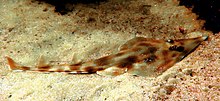
The guitarfish, also referred to as shovelnose rays, are a family, Rhinobatidae, of rays. The guitarfish are known for an elongated body with a flattened head and trunk and small, ray-like wings. The combined range of the various species is tropical, subtropical, and warm temperate waters worldwide.

The shovelnose guitarfish, Pseudobatos productus, is a ray in the family Rhinobatidae. It becomes mature at an estimated seven to eight years old. Males are between 90–100 cm (35–39 in) long, while females are around 99 cm (39 in) at that age. The ray can live up to 11 years, and full-grown sizes are around 120 cm (47 in) for males, and females reach 137 cm (54 in). They range from central California south to the Gulf of California. Morphological and genetic variations occur in the mitochondrial DNA in those found in the Gulf of California, evidencing their isolation from the rest. Because of this, the conservation of this species must be carefully managed to preserve the biological diversity. The shovelnose is considered to be a primitively developed ray, with many features of both sharks and rays.

The milk shark is a species of requiem shark, and part of the family Carcharhinidae, whose common name comes from an Indian belief that consumption of its meat promotes lactation. The largest and most widely distributed member of its genus, the milk shark typically measures 1.1 m (3.6 ft) long, and can be found in coastal tropical waters throughout the eastern Atlantic and the Indo-Pacific regions. Occurring from the surface to a depth of 200 m (660 ft), this species is common near beaches and in estuaries, and has been recorded swimming up rivers in Cambodia. Juveniles are known to inhabit tidal pools and seagrass meadows. The milk shark has a slender body with a long, pointed snout and large eyes, and is a nondescript gray above and white below. This shark can be distinguished from similar species in its range by the long furrows at the corners of its mouth, and seven to 15 enlarged pores just above them.

Rhina ancylostoma, also known as the bowmouth guitarfish, shark ray or mud skate, is a species of ray and a member of the family Rhinidae. Its evolutionary affinities are not fully resolved, though it may be related to true guitarfishes and skates. This rare species occurs widely in the tropical coastal waters of the western Indo-Pacific, at depths of up to 90 m (300 ft). Highly distinctive in appearance, Rhina ancylostoma has a wide and thick body with a rounded snout and large shark-like dorsal and tail fins. Its mouth forms a W-shaped undulating line, and there are multiple thorny ridges over its head and back. It has a dorsal color pattern of many white spots over a bluish gray to brown background, with a pair of prominent black markings over the pectoral fins. This large species can reach a length of 2.7 m (8.9 ft) and weight of 135 kg (298 lb).

The spotted shovelnose ray is a species of fish in the Rhinobatidae family. It is endemic to northern Australia. Its natural habitat is open seas.

Aptychotrema is a genus of guitarfish which belongs to the family Trygonorrhinidae. They were formerly classified in the family Rhinobatidae. They are found off the coast of Australia.

The thornback guitarfish is a species of ray in the family Platyrhinidae, and the only member of its genus. Despite its name and appearance, it is more closely related to electric rays than to true guitarfishes of the family Rhinobatidae. This species ranges from Tomales Bay to the Gulf of California, generally in inshore waters no deeper than 6 m (20 ft). It can be found on or buried in sand or mud, or in and near kelp beds. Reaching 91 cm (36 in) in length, the thornback guitarfish has a heart-shaped pectoral fin disc and a long, robust tail bearing two posteriorly positioned dorsal fins and a well-developed caudal fin. The most distinctive traits of this plain-colored ray are the three parallel rows of large, hooked thorns that start from the middle of the back and run onto the tail.

Rhinobatos is a genus of fish in the Rhinobatidae family. Although previously used to encompass all guitarfishes, it was found to be polyphyletic, and recent authorities have transferred many species included in the genus to Acroteriobatus, Glaucostegus, and Pseudobatos.

The common shovelnose ray, giant shovelnose ray or giant guitarfish is a species of fish in the Rhinobatidae family found in the central Indo-Pacific, ranging from India to the East China Sea, Solomon Islands and northern Australia. It is found in shallow coastal areas to a depth of at least 100 m (330 ft), including mangrove, estuaries and reportedly also in freshwaters. It reaches up to 2.7 m (8.9 ft) in length, and is greyish-brown to yellowish-brown above with a paler snout.
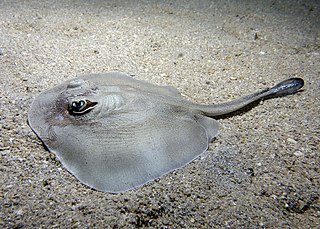
The western shovelnose stingaree is a common species of stingray in the family Urolophidae, inhabiting shallow sandy flats and seagrass beds off southwestern Australia from Perth to Gulf St Vincent. Growing to 37 cm (15 in) long, this small ray has a rounded pectoral fin disc and a blunt, broadly triangular snout. Its nostrils have enlarged lobes along the outer rims and a skirt-shaped curtain of skin between them with a strongly fringed posterior margin. Its tail ends in a lance-like caudal fin and lacks dorsal fins and lateral skin folds. This species is colored grayish to brownish above, sometimes with lighter and darker spots, and pale below, sometimes with darker marginal bands and blotches.

The eastern shovelnose stingaree is a species of stingray in the family Urolophidae, endemic to coastal waters off southeastern Australia, excluding Tasmania. This species has a rounded pectoral fin disc wider than long, a fleshy snout forming an obtuse angle, and a relatively short tail terminating in a caudal fin. Its nostrils have prominent lobes on their outside rims and a skirt-shaped curtain of skin with a strongly fringed trailing margin between them. The dorsal coloration is mostly plain brownish, occasionally with a scattering of darker and/or lighter spots. One of the larger stingarees, it can grow to at least 80 cm (31 in) long.
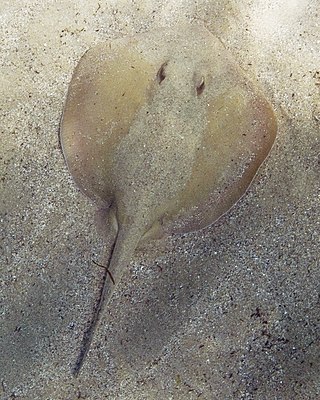
The common stingaree is a species of stingray in the family Urolophidae. The most abundant ray in inshore waters off eastern Australia, it generally inhabits estuaries, sandy flats, and rocky reefs from the shore to a depth of 60 m (200 ft). This plain brownish to grayish species has a rounded pectoral fin disc with a broadly triangular snout. Its nostrils have enlarged lobes on their outer margins and a skirt-shaped curtain of skin with a fringed posterior margin between them. Its tail bears a small dorsal fin before the stinging spine, and terminates in a leaf-shaped caudal fin. This ray can grow to 52 cm (20 in) long.
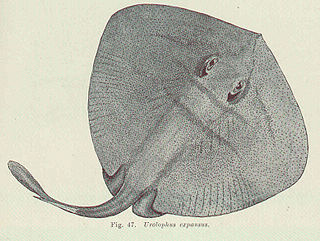
The wide stingaree is a little-known species of stingray in the family Urolophidae, found off southwestern Australia. It typically occurs over sand in water 200–300 m (660–980 ft) deep around the edge of the continental shelf. This species has a broad diamond-shaped pectoral fin disc, a slightly pointed snout, and a tail with a leaf-like caudal fin, skin folds along either side, and no dorsal fins. Between its nostrils is a skirt-shaped curtain of skin. It is grayish green above, with faint bluish lines beside and behind the eyes. The maximum length on record is 52 cm (20 in).
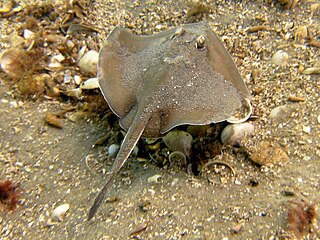
The sparsely spotted stingaree, also known as the white-spotted stingaree or Dixon's stingaree, is a species of stingray in the family Urolophidae, common off the southern Australian coast. Preferring sandy flats and seagrass beds, this benthic ray can be found from close to shore to a depth of at least 150 m (490 ft), and tends to occur deeper in the northern portion of its range. Reaching a length of 57 cm (22 in), this species has a broad, diamond-shaped pectoral fin disc that is typically plain gray in color above with a V-shaped marking between the eyes. Individuals from southerly waters also generally exhibit a smattering of small, dark-edged white spots. This ray is further characterized by a distinctively bell-shaped curtain of skin between the nostrils. Its tail has a skin fold running along either side and a leaf-shaped caudal fin, but no dorsal fin.

The Kapala stingaree is a species of stingray in the family Urolophidae, endemic to inshore waters off southeastern Queensland and New South Wales. It is commonly found on and around rocky reefs at a depth of 10–130 m (33–427 ft). Reaching 51 cm (20 in) in length, the Kapala stingaree has a rounded, diamond-shaped pectoral fin disc and a slender tail, which ends in a leaf-shaped caudal fin and bears lateral skin folds and a small dorsal fin in front of the stinging spine. It has a distinctive bell-shaped curtain of skin between its nostrils. This species is greenish above, with a highly variable pattern of dark markings usually found outside and between the eyes, and over the back and tail.

The banded guitarfish, mottled guitarfish, prickly skate or striped guitarfish is a species of fish in the Trygonorrhinidae family. Originally Z. exasperata was placed in the Rhinobatidae family, however recent mitochondrial DNA analysis shows their placement into the new family of Trygonorrhinidae. They are found from shallow water to a depth of 200 m (660 ft) in the East Pacific from California, United States, to Mazatlan, Mexico, including the Gulf of California. The species has also been recorded further south, but this likely involves its close relative, the southern banded guitarfish.

Narcine entemedor, the giant electric ray or Cortez electric ray, is a species of numbfish, family Narcinidae, native to the eastern Pacific Ocean from the Gulf of California to Panama. It is found in shallow water on sandy bottoms and sometimes adjacent to reefs. This species is closely related to the lesser electric ray from the western Atlantic, and may represent the same species. The specific epithet entemedor seems to be the Spanish equivalent of "intimidator".
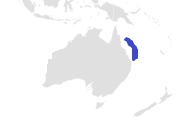
The tropical sawshark, Pristiophorus delicatus, is a recently described species of sawshark, family Pristiophoridae, formerly known in literature as Pristiophorus sp. B. It is endemic to northeastern Australia, found on the upper continental slope off Queensland from south of the Samaurez Reef, at a depth of 246–405 meters (807–1,329 ft). Its specific epithet delicatus is Latin for "delicate", referring to the fine teeth on its saw-like rostrum.
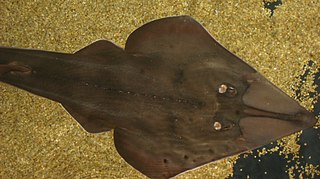
The blackchin guitarfish is a species of cartilaginous fish in the family Rhinobatidae. It is native to the eastern Atlantic Ocean and the Mediterranean Sea. It is a bottom-dwelling fish feeding on crustaceans, other invertebrates and fish. The females give birth to live young. Its lifestyle makes it vulnerable to trawling and other fishing methods, populations seem to be declining and it is subject to intensive fishing pressure, with its fins being sold into the Asian market. The International Union for Conservation of Nature has assessed its conservation status as being "critically endangered".

Trygonorrhinidae, the banjo rays, is a family of rays, comprising eight species in three genera. They were formerly classified in the family Rhinobatidae.
